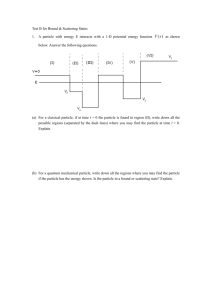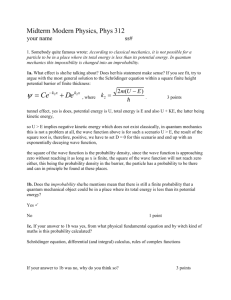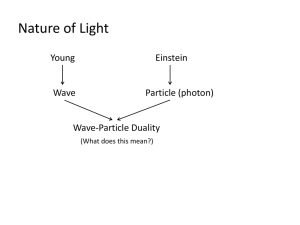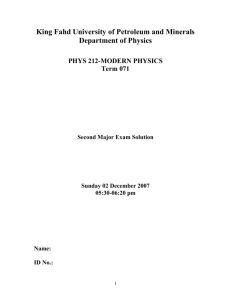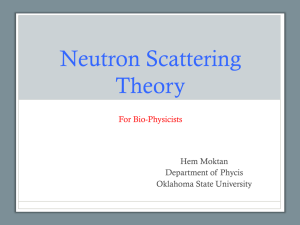Bound and Scattering State
advertisement
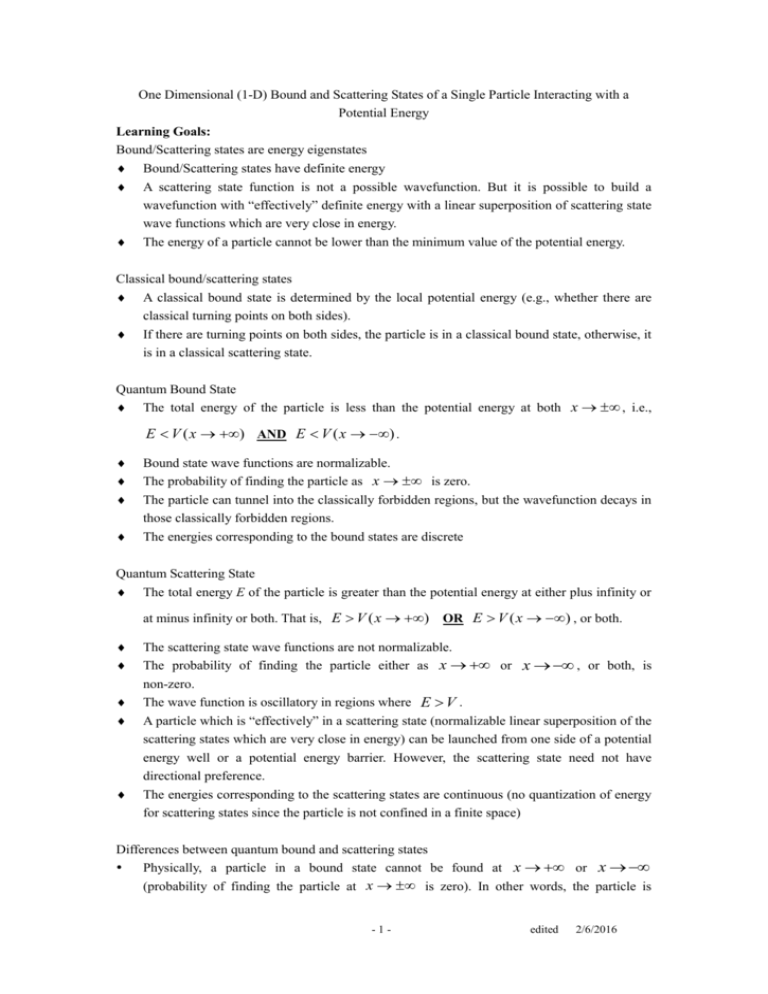
One Dimensional (1-D) Bound and Scattering States of a Single Particle Interacting with a Potential Energy Learning Goals: Bound/Scattering states are energy eigenstates Bound/Scattering states have definite energy A scattering state function is not a possible wavefunction. But it is possible to build a wavefunction with “effectively” definite energy with a linear superposition of scattering state wave functions which are very close in energy. The energy of a particle cannot be lower than the minimum value of the potential energy. Classical bound/scattering states A classical bound state is determined by the local potential energy (e.g., whether there are classical turning points on both sides). If there are turning points on both sides, the particle is in a classical bound state, otherwise, it is in a classical scattering state. Quantum Bound State The total energy of the particle is less than the potential energy at both x , i.e., E V ( x ) AND E V ( x ) . Bound state wave functions are normalizable. The probability of finding the particle as x is zero. The particle can tunnel into the classically forbidden regions, but the wavefunction decays in those classically forbidden regions. The energies corresponding to the bound states are discrete Quantum Scattering State The total energy E of the particle is greater than the potential energy at either plus infinity or at minus infinity or both. That is, E V ( x ) OR E V ( x ) , or both. The scattering state wave functions are not normalizable. The probability of finding the particle either as x or x , or both, is non-zero. The wave function is oscillatory in regions where E V . A particle which is “effectively” in a scattering state (normalizable linear superposition of the scattering states which are very close in energy) can be launched from one side of a potential energy well or a potential energy barrier. However, the scattering state need not have directional preference. The energies corresponding to the scattering states are continuous (no quantization of energy for scattering states since the particle is not confined in a finite space) Differences between quantum bound and scattering states Physically, a particle in a bound state cannot be found at x or x (probability of finding the particle at x is zero). In other words, the particle is -1- edited 2/6/2016 “bounded” in a localized region. However, a particle in a scattering state, which are not normalizable, can be found at x or x or both. Mathematically, a bound state wavefunction rapidly decays as x , even though the wavefunction can be non-zero in a classically forbidden region. Scattering state wavefunction is oscillatory even at x at least on one side (as x or x ). 1. Which one of the following statements is correct about the bound state and scattering state energy levels? A. Both bound state and scattering state energy levels are discrete. B. Both bound state and scattering state energy levels are continuous. C. Bound state energy levels are discrete and scattering state energy levels are continuous. D. Bound state energy levels are continuous and scattering state energy levels are discrete. E. None of the above. 2. Consider the following conversation between Andy and Caroline. Andy: I don’t understand the answer to the previous question. Why are the bound state energy levels discrete? Why can’t the scattering state energy levels also be discrete? Caroline: Remember the examples we have learned for quantum systems that only allow bound states, e.g., the infinite square well or the simple harmonic oscillator potential energy. The finite square well potential energy allows both bound states and scattering states. The bound states have discrete energy levels. However, if we increase the width of the finite square well, the two adjacent energy levels become closer but are still discrete. Only if the width increases to infinity, the energy levels will become continuous. The bound states can be considered to be due to confinement of a particle in a potential energy well of finite width and depth. The confinement makes the bound state energy levels are discrete. On the other hand, the energy levels of the scattering states are continuous because there is no such confinement to localize the particle. Do you agree or disagree with Caroline? Explain. -2- edited 2/6/2016 Figure 1: Simple Harmonic Oscillator Potential Energy 3. As shown in Fig.1, a toy car with total energy E is moving without friction in a 1D simple harmonic oscillator potential energy well (e.g., a toy car connected to a spring). Choose all of the following statements that are correct about this classical system. (I) (II) (III) The car is in a classical bound state. The car is bound between x=a and x=b, it cannot be found anywhere outside that region. x=a and x=b are called classical turning points. When the car reaches one of them, it stops momentarily and turns back. (a) (I) only (b) (I) and (II) only (c) (I) and (III) only (d) (II) and (III) only (e) All of the above 4. In the preceding problem, suppose we replace the classical toy car with a quantum particle. The particle with total energy E is interacting with a 1D harmonic potential well as shown in Fig. 1. Choose all of the following statements that are correct about this quantum mechanical system. (I) (II) (III) The particle is in a quantum mechanical bound state. The particle is bound between x=a and x=b, it cannot be found anywhere outside that region. There is a finite probability that the particle will be found outside the region between x=a and x=b. (a) (I) only (b) (II) only (c) (III) only (d) (I) and (II) only (e) (I) and (III) only -3- edited 2/6/2016 5. A toy car with energy E is initially between x=a and x=b in the potential shown in Figure 2. Choose the statement that is correct about the toy car (classical system). Figure 2 (a) It is in a bound state and it will remain between x=a and x=b. (b) It is in a scattering state and there is a finite probability of finding it at x . (c) Nothing can be said without knowing the mass and speed explicitly. (d) Nothing can be said without knowing the exact initial position of the car between x=a and x=b. (e) It is in a bound state between a<x<b and in a scattering state elsewhere. 6. Consider the following quantum mechanical system: An electron with energy E is interacting with the potential energy well as shown in Figure 2. Choose the statement that is correct about the electron. (a) It is in a bound state and it will stay between x=a and x=b. (b) It is in a scattering state and there is a finite probability of finding it at x . (c) Nothing can be said without knowing the Hamiltonian Ĥ explicitly. (d) Nothing can be said without knowing the initial state (at time t=0) of the electron (i.e., ( x, t 0) ) exactly. (e) It is in a bound state between x=a & x=b and in a scattering state elsewhere. 7. Summarize at least three differences between the classical and quantum bound states. -4- edited 2/6/2016 8. Choose all of the following statements that are correct. (I) (II) (III) (IV) A quantum mechanical bound state is the same as a classical bound state. In a quantum mechanical bound state, the particle cannot be found in the classically forbidden region. In a quantum mechanical bound state, the particle can be found in the classically forbidden region, but its wave function will decay in that region. In a quantum mechanical bound state, the particle can be found in the classically forbidden region and it can have an oscillatory wave function in that region. (a) (II) only (b) (III) only (c) (IV) only (d) (I) and (II) only (e) (III) and (IV) only 9. Choose all of the following statements that are correct about the infinite square well shown below (V(x)=0 for 0<x<a and V(x)=infinity otherwise. Figure 3: Infinite Square Well (I) It only allows for bound states, because the potential energy V (x ) at x . (II) (III) The wave function of a bound particle will decay rapidly outside the well, but there is a finite probability that it will be found outside the well. The wave function of a bound particle will go to zero at the boundaries of the well. The probability of finding it outside the well is exactly zero. (a) (I) only (b) (II) only (c) (III) only (d) (I) and (II) only (e) (I) and (III) only -5- edited 2/6/2016 10. Choose all of the following statements that are correct about an electron in a linear superposition of bound states in the infinite square well shown in the preceding problem. (I) (II) It cannot be found in the classically forbidden regions. It cannot be found infinitely far away from the potential energy well at x . (III) It cannot be more localized than the width of the well, e.g., ( x, t 0) cannot be non-zero only in region 0<x<a/2 and be zero everywhere in the region 0 x a. (a) (II) only (b) (I) and (II) only (c) (I) and (III) only (d) (II) and (III) only (e) All of the above. 11. Explain why a simple harmonic oscillator (SHO) potential energy will allow both bound and scattering states or only bound states. 12. Choose all of the following that are correct about an electron interacting with a 1D simple harmonic oscillator potential energy well. Figure 4: Harmonic Oscillator Potential Energy (I) The SHO potential energy well only allows bound states, because the potential energy V (x ) as x . (II) (III) The wave function of a bound particle with a given energy will decay rapidly in the classically forbidden region, but there is a finite probability that it will be found in that region. The wave function of a bound particle will discontinuously go to zero at the well boundaries. The probability of finding it outside the well is zero everywhere. (a) (I) only (b) (II) only (c) (III) only (d) (I) and (II) only (e) (I) and (III) only -6- edited 2/6/2016 Simulation 1: SHO As shown in the figure below, a particle with energy E is in a SHO potential energy well. Answer questions (i) to (iii) before starting the simulation. (i) Is the wavefunction in the regions x a and x b oscillating or decaying? Explain. (ii) Is the wavefunction in the region a x b oscillating or decaying? Explain. (iii) What is the probability of finding the particle at infinity for the SHO potential energy? Now double click “bound_state.jar” to open the simulation. On the upper right corner of the window, you can select the type of the potential well. Take “square well” as an example. The upper window shows the energy levels of the system. Green lines are the allowed energy levels. The red line is the energy level being selected. The purple line represents the potential energy well. You can change the height and width of the potential energy well by clicking and dragging the corresponding arrows on the purple line. The lower window shows the absolute square of the energy eigenfunction (probability density). The white graph in the lower window corresponds to the selected energy (red line) in the upper window. When you put your mouse on one of the green lines (allowed energy) in the upper channel, that energy level will turn yellow and the corresponding probability density will be shown as a yellow line in the lower window. -7- edited 2/6/2016 (iv) Now choose the “Harmonic Oscillator” as the potential well in the simulation menu on the sidebar. Observe the shape of the absolute square of the different energy eigenfunctions to check your answers to questions (i), (ii) and (iii). Are these simulation results the same as your predictions? If not, reconcile the difference between your prediction and simulation. (v) Sketch the absolute square of the first three energy eigenfunctions of the infinite square well below. Summarize the similarities and differences between the shapes of the bound state wavefunctions of an infinite square well and a SHO well. 13. Which one of the following statements is correct about an electron interacting with a finite square well with energy En as shown in the figure below? Fig 5. Finite Square Well (a) It is in a bound state. (b) It is in a scattering state. (c) It is in a bound state between x=0 and x=a and in a scattering state everywhere else. (d) Such an energy is not possible because energy should be higher outside the well. (e) It cannot be determined without knowing the wave function . 14. Choose all of the following that are correct about an electron in a bound state interacting with the finite square well shown in Fig 5. (I) Its wave function decays rapidly outside the boundaries of the well (in the classically forbidden regions). (II) Its wave function is normalizable. (III) The probability of finding it is zero as x . (a) (II) only (b) (I) and (II) only (c) (I) and (III) only (d) (II) and (III) only (e) All of the above. -8- edited 2/6/2016 15. Choose all of the following statements that are correct about an electron in a bound state interacting with the finite square well shown in Fig 5. (I) Its wave function is zero outside in the well. (II) Its energy must be less than zero. (III) It can only have discrete energies. (a) (I) only (b) (II) only (c) (I) and (II) only (d) (I) and (III) only (e) (II) and (III) only Simulation 2: Bound states in a finite square well. Use the same program as in simulation 1 and select “square well” as the potential energy well. (i) Observe the possible energy levels (green lines) of the electron interacting with a finite square well (purple line). Is the energy of the electron lower than the potential energy inside the finite square well? Is the energy of the electron lower than the potential energy outside the finite square well? Explain your observations. (ii) Predict whether the number of energy levels of the electron would increase or decrease if you increase the depth of the finite square well. Check your prediction with the simulation. (iii) Predict whether the number of energy levels of the electron would increase or decrease if you increase the width of the finite square well. Check your prediction with the simulation. 16. Which one of the following statements is correct about an electron in a finite square well with energy E as shown in the figure below? Fig 6. Finite Square Well (a) It is in a bound state. (b) It is in a scattering state. (c) Such an energy is not possible because energy should be lower inside the well. (d) It cannot be determined without knowing the wave function . (e) None of the above. -9- edited 2/6/2016 17. Choose all of the following statements that are true about an electron launched from x with energy E > 0 interacting with the finite square well as shown in Figure 7. Figure 7: Finite Square Well of width a (I) (II) (III) It will get transmitted to the right with 100% certainty. In general, there is a non-zero probability of it bouncing off the potential energy well and a non-zero probability of it transmitting through the well. Its wave function will decay between x=0 and x=a. (a) (I) only (b) (II) only (c) (III) only (d) (II) and (II) only (e) None of the above. Simulation 3: Scattering states of a finite square well Suppose we send a particle from x toward a finite square well as described in problem 15. Answer questions (i) to (iii) before starting the simulation program. (i) Is the probability of finding the particle at x zero or non-zero? Explain. (ii) Is the amplitude of the wavefunction the same on both sides of the finite square well? Explain. (iii) Is the wavefunction inside the well decaying or oscillating? Explain. - 10 - edited 2/6/2016 Now double click “quantum-tunneling” to open the simulation program. In the upper right corner, you can select the type of potential energy well or potential step. Take “barrier/well” as an example. The default form of the wavefunction is a wave packet. Change the wavefunction form to “plane wave” on the right side of the program window. In the upper window, the green line represents the energy of the incident particle (or wavefunction) and the purple line is the potential energy. You can click and drag the corresponding arrows to change the energy of the incident particle and the depth/width of the potential energy well. If you increase the height of the potential energy above zero, the potential energy function will become a potential energy barrier. The wavefunction of the particle can be observed in the middle window. You can start/stop the time evolution of the wavefunction by clicking the button at the lower middle of the program window. The absolute square of the wavefunction is shown in the bottom window. (iv) Select the potential energy as “barrier/well” and drag the potential energy height below zero (suggested around -0.75eV) to make it a finite square well. Observe the simulation to check your prediction in (i), (ii) and (iii). Is the simulation result the same as your prediction? Explain. (v) Observe the simulation and sketch the “probability density” below. Is the absolute square of the wavefunction (x) at the right side of the well a constant? What about the (x) 2 2 on the left side? Explain. (vi) Decrease the well depth and make it equal to zero, so that the potential energy is zero everywhere and the electron behaves like a free particle. Predict whether the absolute square of the wavefunction (x) on the left and right sides would be constants. Use the simulation 2 to check your prediction. (vii) Explain the difference in (v) and (vi). Why is the amplitude of the wavefunction on the left side a constant when the depth of the potential energy well is zero? - 11 - edited 2/6/2016 Answer question (viii) without using the simulation. (viii) The wavepacket can be considered as a superposition of many plane waves. When the incident wavepacket from x encounters a potential energy well, can you predict whether it will be bounced back? Explain. (ix) Change the wavefunction form to “wave packet” on the right side of the program window. Start the time evolution and observe how the wave packet evolves. Pause the time evolution around t=10 fs. Is the wavefunction at the left side of the potential energy well zero or non-zero? Is this result consistent with your prediction in the previous problem (question viii)? Explain. 18. As shown below, an electron is not sent from one side of the one dimensional finite square well but is still in a scattering state (assume that the energy is very localized around a particular value). Choose all of the following wave functions that are possible scattering state wave functions for this electron. (a) (I) only (b) (II) only (c) (III) only (d) (I) and (II) only (e) (II) and (III) only 19. Explain your reasoning for problem 16. - 12 - edited 2/6/2016 20. Consider the following conversation between Sally and Harry. Harry: How could a particle be in a scattering state without directional preference? I think the particle in a scattering state must be sent from either the left or the right side of the potential energy well. Sally: The directional preference is not necessary for a scattering state. The scattering state is an energy eigenstate of the system with energy of the particle higher than the potential energy at x . Harry: But scattering state wave function is not normalizable so how can it represent the state of a particle? Sally: You are correct. However, we can make a normalizable wave function by using scattering state wave functions with energy in a narrow range and in these situations we can effectively say that a particle is in a scattering state even though it is actually a linear superposition of scattering states with a narrow range of energy and the wave function goes to zero far away from the well at x . Do you agree or disagree with Sally? Explain. 21. Choose all of the following statements that are correct about an electron with energy E interacting with a potential energy barrier, as shown in the figure below. (a) It is in a bound state. (b) It is in a scattering state. (c) Such an energy level is not possible because energy should be higher inside the barrier. (d) It cannot be determined without knowing the wave function . (e) None of the above. 22. Choose all of the following statements that are correct about an electron with energy E interacting with a potential energy barrier, as shown in the figure below. (a) It is in a bound state. (b) It is in a scattering state. (c) Such energy is not possible because energy should be lower outside the well. (d) It cannot be determined without knowing the wave function . (e) None of the above. - 13 - edited 2/6/2016 23. Which of the following statements is correct about the potential energy barrier shown in Figure 8? Figure 8 (a) It only allows bound states. (b) It only allows scattering states. (c) It allows both bound states and scattering states. (d) It allows bound states inside the barrier and scattering states outside the barrier. (e) Nothing can be said without knowing the Hamiltonian Ĥ . 24. Consider the conversation below between Sally and Harry: Sally: Why does the potential energy barrier only allow for scattering states but no bound states? Harry: It doesn’t make sense at first, but think of a classical example. A potential energy barrier, i.e., potential energy V(x)>0 (when V(x)=0 at x ) as shown in Figure 8 means it is a repulsive potential energy. Similarly, a well means it is an attractive potential energy. Imagine an electron moving towards and feeling the repulsive force of another stationary electron. The incoming electron can scatter off the stationary electron, but it won’t ever be bound. Sally: I see. However, if the potential energy is due to interaction between a proton and an electron, it will correspond to a potential energy well. For example, in a hydrogen atom, the electron is, in general, in a bound state. However, it can go into a scattering state if it absorbs sufficient energy. Harry: You are correct. Similarly, an electron can interact with a proton via the Coulomb interaction which is attractive but if it is not close enough to the proton it will not be in a bound state. Sally: Yes. In that case the electron will be in a scattering state. Do you agree or disagree with Harry and Sally? Explain. - 14 - edited 2/6/2016 Simulation 4: scattering state of finite barrier Suppose we send a particle from x toward a finite square barrier shown in Figure 8. Answer questions (i) and (ii) before starting the simulation program. (i) When the energy of the incident electron is lower than the potential energy barrier, will the wavefunction have a non-zero value beyond the potential energy barrier? What is the shape of wavefunction inside the barrier? (ii) When the energy of the incident electron is higher than the potential energy barrier, will the wavefunction have a non-zero value beyond the potential barrier? What is the shape of wavefunction inside the barrier? (iii) Use the same simulation program as in simulation 3. Select the potential energy as “barrier/well” and drag the potential energy height above zero (better around +0.75) to make it a finite square barrier. Drag the energy level of the particle below the highest point of the barrier. Start the time evolution and observe the simulation. Is the simulation result consistent with your prediction in question (i)? Explain. (iv) Change the energy level height for the particle but keep it below the highest point of the barrier. Compare the wavefunction and probability density for different heights of the particle energy levels. Describe the similarities and differences below. (v) Drag the energy level of the particle above the highest point of the barrier. Start the time evolution and observe the simulation. Is the simulation result consistent with your prediction in question (ii)? Explain. (vi) Change the energy level height of the particle but keep it above the highest point of the barrier. Compare the wavefunction and probability density for different heights of particle energy levels. Describe the similarities and differences below. - 15 - edited 2/6/2016 (vii) If the energy of the incident electron is higher than the potential energy barrier, will there be a reflected component to the wavefunction due to reflection by the potential barrier? Explain. How does the wavefunction and probability density shown in the simulation support your statement? Answer question (viii) before using the simulation. (viii) Suppose the incident wave function is in the form of a wave packet. When the incident wavepacket from x encounters a potential energy well, can you predict whether there will be a reflected component to the wavefnction due to reflection by the well? Explain. (ix) Change the wavefunction form to “wave packet” on the right side of the program window. Start the time evolution and observe how the wave packet evolves. Pause the time evolution around t=10 fs. Is the wavefunction at the left side of the potential energy well zero or non-zero? Is this result consistent with your prediction in the preceding problem (question viii)? Explain. 25. Sally makes a concatenated chain of 100 gold atoms in vacuum. Ignore the interaction of the electrons with each other and with the gold nuclei. Assume that only the valence electrons are important for the chemical properties. Each gold atom has one valence electron and all valence electrons inside the chain are free with motion confined along the chain in one dimension. The probability of valence electrons leaking from the gold chain into vacuum is small. Which one of the following models best describes this system of 100 atoms? (a) Hydrogen atom. (b) A single 1-D finite square well which can be approximated as an infinite square well. (c) A single 1-D simple harmonic oscillator. (d) A single 1-D delta function potential well. 26. Sally makes a concatenated chain of 300 gold atoms. All assumptions in question 23 hold. Choose all of the following statements that correctly compare or contrast the model for this system with the one in question 23. Assume it is approximately a 1D infinite square well. (I) The depth of the well is the same because the same type of atom is used. (II) The width of the well is larger because there are more atoms in the chain. (III) The energy levels are given by E n n 2 2 2 , so the energy levels will be 2ma 2 closer together, since the well is wider. (a) (I) only (b) (II) only (c) (I) and (II) only (d) (II) and (III) only (e) All of the above. - 16 - edited 2/6/2016 27. Sally makes a concatenated chain of 108 gold atoms so that the end effects are negligible and the chain can be considered infinitely long. Assume that all valence electrons inside the chain are free to move along the chain in one dimension. Which one of the following models most appropriately describes this system? (a) Free particle in one dimension. (b) A single 1-D delta function potential well. (c) A single 1-D finite square well. (d) A single 1-D simple harmonic oscillator. 28. Sally makes a one dimensional concatenated chain consisting of insulating atoms of type A and metal atoms of type B as shown in Figure 9, so that 100 atoms of type B are enclosed between 106 atoms of type A on each side. Assume that each valence electron in type B atom is free to move inside the chain of type B atoms, but encounters a finite constant potential energy barrier in the A region. Atoms of type A do not have free electrons. Which one of the following models most appropriately describes this system? (a) A single 1-D infinite square well. (b) A single 1-D finite square well. (c) A single 1-D simple harmonic oscillator. (d) A single 1-D delta function well. (e) None of the above. AAAAAAAAAA AAA AAAAAA A BBBBBBB ... B AAAAAAAAAA AAAAAAAAA A . ... ... 106 atoms 100 atoms 106 atoms Figure 9: The ABA chain Sally made in question 26 - 17 - edited 2/6/2016
